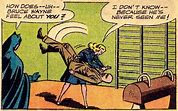I don't remember where I recently heard someone bring up DC's possible reasons for letting editor Julie Schwartz kill off the faithful butler Alfred in 1964, but it was probably in a podcast like this one. The cited podcast reports, but does not credence, the idea that Schwartz was in any way worried about the alleged problems of having three men live alone in Wayne Manor, which had been raised by Wertham in SEDUCTION OF THE INNOCENT ten years before. Allegedly, the story goes, Schwartz immediately brought in Dick Grayson's Aunt Harriet to occupy the mansion, so that her feminine presence would allay suspicions about any hanky-panky between Bruce and Dick.
This unfounded theory intrigued me enough to blow an hour or so scanning an online pirate site for all the Schwartz issues of BATMAN and DETECTIVE COMICS after the introduction of Aunt Harriet and up until the revival of Alfred, and guess what?
Auntie's hardly in most of the stories. If anything, she was usually just seen serving dinner for a few panels, if that, and she had far less interaction with Bruce and Dick than the character in the BATMAN teleseries did. The comic-book Aunt Harriet didn't know the secret identities of the millionaire and his ward, but if Schwartz had any idea of having Harriet, through intention or accident, endanger the heroes' clandestine activities, he didn't follow through. There's exactly one story wherein Harriet suspects that her charges might be the Dynamic Duo. But when she's proven wrong through the usual shenanigans, the matter is never raised again. After Alfred's brought back to life and returns to Wayne Manor, there's a moment in which Harriet plans to leave, but Bruce and Dick talk her into staying. They needn't have bothered, for though Schwartz remained editor for about fifteen more years, even he didn't bother insisting on her presence, and she just faded into the woodwork.
In addition, Schwartz barely took advantage of an easy way to counter homosexual suspicions: by giving the two heroes heterosexual relationships. Fans will never know if this was the reason for the introduction of various female presences during the Batman-run of editor Jack Schiff-- pesky photographer Vicky Vale in 1948, Batwoman in 1956, and Bat-Girl in 1961. Yet the way Batwoman and Bat-Girl were paired off with Batman and Robin respectively gave some credence to the "Placate Wertham Theory," as did the long exile of Catwoman from DC comics due to Wertham's complaints about her. When Schwartz took over both Bat-books in 1964, he dumped all the rotating Schiff characters-- but that didn't mean he couldn't have come up with one or two token girlfriends to take the place of the Schiff Sirens.
Schwartz's intention to focus on the "detective" angle of Batman's persona resulted in a lot of stories with almost zero female presence. Occasionally Batman and Robin would help out some poor pitiful damsel whose boyfriend was in peril somewhere, but really-- if there had been homosexual readers who wanted to fantasize a "wish dream" of Batman and Robin together, it would have been easy to ignore Aunt Harriet's nearly nugatory presence to facilitate such fantasies.
There was one early, almost half-hearted attempt to make a romance possible, but for Bruce Wayne rather than Batman. In BATMAN #165 (1964), Batman meets a serious young policewoman, Patricia Powell, who discloses to the masked hero that she has a thing for Bruce Wayne, even though she's only seen the handsome millionaire from afar. This short tale, and a follow-up in the next issue, tease the reader with what may happen when Patricia finally gets the chance to meet her idol face to face. But Schwartz evidently lost interest in the idea, for the second story doesn't even resolve its "what happens when they meet" cliffhanger.
Not until after 1966, when Alfred was back and Harriet was slowly on her way out, did the two Bat-features begin re-emphasizing female characters. Some became established members of the mythos, like Poison Ivy, the second Batgirl, and a revived Catwoman. Others only appeared only once or twice, like Alfred's niece Daphne Pennyworth, for whom Robin briefly had a thing, but were still more memorable than the Schwartz "damsels" from the first couple of years. (Incidentally, the backstory of Niece Daphne was possibly recycled into that of the Batgirl in the 1997 BATMAN AND ROBIN.) The slow increase in memorable Bat-females after 1966 was probably the reaction of Schwartz, or one of his superiors, to the success of the teleseries that year, that it was a good idea to include a few more charismatic females, as the TV show did.
So my laborious answer to the "Aunt Harriet" question is that if Schwartz had some hope that her presence would inspire good detective stories, that hope was dashed, because most of the scripts just shunted the old lady off to the side. Schwartz may not have had any strong reason for getting rid of Alfred, who in the past had proved quite useful to Bat-writers seeking to craft detective-stories. But rather than having some arcane fear about "three men living together," Schwartz probably just wanted another means of divorcing his regime from that of his predecessor. The fact that Alfred didn't just get written out like Vicky, Batwoman and Bat-Girl was probably a sop to those fans who would have complained had the faithful butler simply vanished.





No comments:
Post a Comment